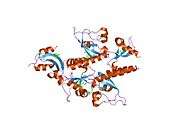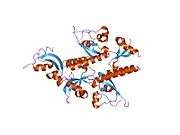CHD1
Chromodomain-helicase-DNA-binding protein 1 is an enzyme that in humans is encoded by the CHD1 gene.[5][6][7]
The CHD family of proteins is characterized by the presence of chromo (chromatin organization modifier) domains and SNF2-related helicase/ATPase domains. CHD genes alter gene expression possibly by modification of chromatin structure thus altering access of the transcriptional apparatus to its chromosomal DNA template.[7]
Interactions
CHD1 has been shown to interact with Nuclear receptor co-repressor 1.[8]
References
- 1 2 3 GRCh38: Ensembl release 89: ENSG00000153922 - Ensembl, May 2017
- 1 2 3 GRCm38: Ensembl release 89: ENSMUSG00000023852 - Ensembl, May 2017
- ↑ "Human PubMed Reference:".
- ↑ "Mouse PubMed Reference:".
- ↑ Delmas V, Stokes DG, Perry RP (Apr 1993). "A mammalian DNA-binding protein that contains a chromodomain and an SNF2/SWI2-like helicase domain". Proc Natl Acad Sci U S A. 90 (6): 2414–8. Bibcode:1993PNAS...90.2414D. doi:10.1073/pnas.90.6.2414. PMC 46097. PMID 8460153.
- ↑ Woodage T, Basrai MA, Baxevanis AD, Hieter P, Collins FS (Nov 1997). "Characterization of the CHD family of proteins". Proc Natl Acad Sci U S A. 94 (21): 11472–7. Bibcode:1997PNAS...9411472W. doi:10.1073/pnas.94.21.11472. PMC 23509. PMID 9326634.
- 1 2 "Entrez Gene: CHD1 chromodomain helicase DNA binding protein 1".
- ↑ Tai, Helen H; Geisterfer Margit; Bell John C; Moniwa Mariko; Davie James R; Boucher Lorrie; McBurney Michael W (Aug 2003). "CHD1 associates with NCoR and histone deacetylase as well as with RNA splicing proteins". Biochem. Biophys. Res. Commun. United States. 308 (1): 170–6. doi:10.1016/S0006-291X(03)01354-8. ISSN 0006-291X. PMID 12890497.
External links
- Human CHD1 genome location and CHD1 gene details page in the UCSC Genome Browser.
Further reading
- Stokes DG, Perry RP (1995). "DNA-binding and chromatin localization properties of CHD1". Mol. Cell. Biol. 15 (5): 2745–53. PMC 230505. PMID 7739555.
- Bonaldo MF, Lennon G, Soares MB (1997). "Normalization and subtraction: two approaches to facilitate gene discovery". Genome Res. 6 (9): 791–806. doi:10.1101/gr.6.9.791. PMID 8889548.
- Kelley DE, Stokes DG, Perry RP (1999). "CHD1 interacts with SSRP1 and depends on both its chromodomain and its ATPase/helicase-like domain for proper association with chromatin". Chromosoma. 108 (1): 10–25. doi:10.1007/s004120050347. PMID 10199952.
- Strausberg RL, Feingold EA, Grouse LH, et al. (2003). "Generation and initial analysis of more than 15,000 full-length human and mouse cDNA sequences". Proc. Natl. Acad. Sci. U.S.A. 99 (26): 16899–903. Bibcode:2002PNAS...9916899M. doi:10.1073/pnas.242603899. PMC 139241. PMID 12477932.
- Salomon AR, Ficarro SB, Brill LM, et al. (2003). "Profiling of tyrosine phosphorylation pathways in human cells using mass spectrometry". Proc. Natl. Acad. Sci. U.S.A. 100 (2): 443–8. Bibcode:2003PNAS..100..443S. doi:10.1073/pnas.2436191100. PMC 141014. PMID 12522270.
- Tai HH, Geisterfer M, Bell JC, et al. (2003). "CHD1 associates with NCoR and histone deacetylase as well as with RNA splicing proteins". Biochem. Biophys. Res. Commun. 308 (1): 170–6. doi:10.1016/S0006-291X(03)01354-8. PMID 12890497.
- Ota T, Suzuki Y, Nishikawa T, et al. (2004). "Complete sequencing and characterization of 21,243 full-length human cDNAs". Nat. Genet. 36 (1): 40–5. doi:10.1038/ng1285. PMID 14702039.
- Brandenberger R, Wei H, Zhang S, et al. (2005). "Transcriptome characterization elucidates signaling networks that control human ES cell growth and differentiation". Nat. Biotechnol. 22 (6): 707–16. doi:10.1038/nbt971. PMID 15146197.
- Sims RJ, Chen CF, Santos-Rosa H, et al. (2006). "HUMAN BUT NOT YEAST CHD1 BINDS DIRECTLY AND SELECTIVELY TO HISTONE H3 METHYLATED AT LYSINE 4 VIA ITS TANDEM CHROMODOMAINS". J. Biol. Chem. 280 (51): 41789–92. doi:10.1074/jbc.C500395200. PMC 1421377. PMID 16263726.
- Flanagan JF, Mi LZ, Chruszcz M, et al. (2006). "Double chromodomains cooperate to recognize the methylated histone H3 tail". Nature. 438 (7071): 1181–5. Bibcode:2005Natur.438.1181F. doi:10.1038/nature04290. PMID 16372014.
- Olsen JV, Blagoev B, Gnad F, et al. (2006). "Global, in vivo, and site-specific phosphorylation dynamics in signaling networks". Cell. 127 (3): 635–48. doi:10.1016/j.cell.2006.09.026. PMID 17081983.
- Okuda M, Horikoshi M, Nishimura Y (2007). "Structural polymorphism of chromodomains in Chd1". J. Mol. Biol. 365 (4): 1047–62. doi:10.1016/j.jmb.2006.10.039. PMID 17098252.
- Ewing RM, Chu P, Elisma F, et al. (2007). "Large-scale mapping of human protein–protein interactions by mass spectrometry". Mol. Syst. Biol. 3 (1): 89. doi:10.1038/msb4100134. PMC 1847948. PMID 17353931.
This article is issued from
Wikipedia.
The text is licensed under Creative Commons - Attribution - Sharealike.
Additional terms may apply for the media files.










